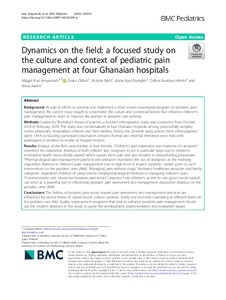Dynamics on the field: a focused study on the culture and context of pediatric pain management at four Ghanaian hospitals
Abigail Kusi Amponsah; Victoria Bam; Anna Axelin; Evans Oduro; Collins Kwadwo Ahoto; Joana Kyei-Dompim
https://urn.fi/URN:NBN:fi-fe2021042826848
Tiivistelmä
Background
As part of efforts to develop and implement a short course educational program on pediatric pain management, the current study sought to understand the culture and contextual factors that influence children’s pain management in order to improve the practice in pediatric care settings.
Methods
Guided by Bourdieu’s theory of practice, a focused ethnographic study was conducted from October, 2018 to February, 2019. The study was contextualized at four Ghanaian hospitals among purposefully sampled nurses, physicians, hospitalized children and their families. During the 20-week study period, three ethnographers spent 144 h conducting participant-observation sessions. Formal and informal interviews were held with participants in addition to review of hospital records.
Results
Analysis of the field data resulted in four themes. “Children’s pain expression and response of caregivers” described the disposition (habitus) of both children and caregivers to act in particular ways due to children’s incomplete health status (bodily capital) which caused them pain and also resulted in discomforting procedures. “Pharmacological pain management practices and attitudes” elucidated the use of analgesics as the mainstay disposition (habitus) in children’s pain management due to high level of respect (symbolic capital) given to such interventions on the pediatric units (field). “Managing pain without drugs” illustrated healthcare providers and family caregivers’ disposition (habitus) of using diverse nonpharmacological methods in managing children’s pain. “Communication and interaction between pain actors” depicted how children’s access to care givers (social capital) can serve as a powerful tool in influencing pediatric pain assessment and management disposition (habitus) on the pediatric units (field).
Conclusions
The habitus of pediatric pain actors toward pain assessment and management practices are influenced by various forms of capital (social, cultural, symbolic, bodily and economic) operating at different levels on the pediatric care field. Quality improvement programs that seek to enhance pediatric pain management should use the insights obtained in this study to guide the development, implementation and evaluation stages.
Kokoelmat
- Rinnakkaistallenteet [19207]
